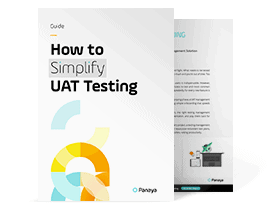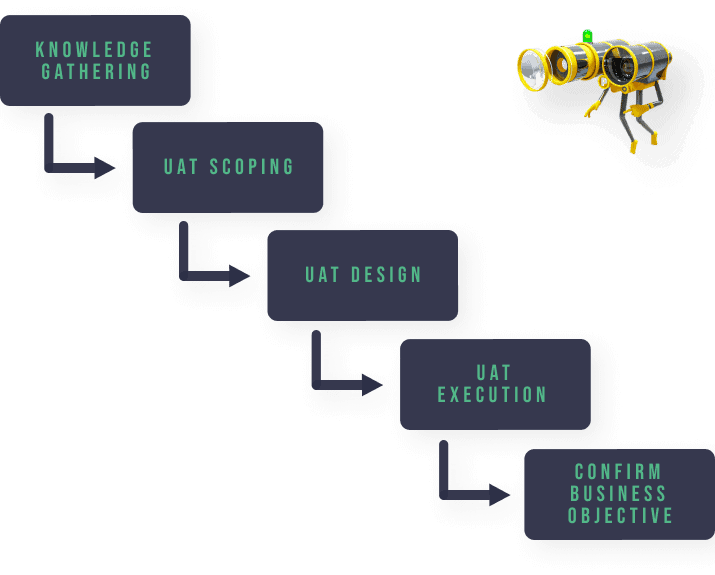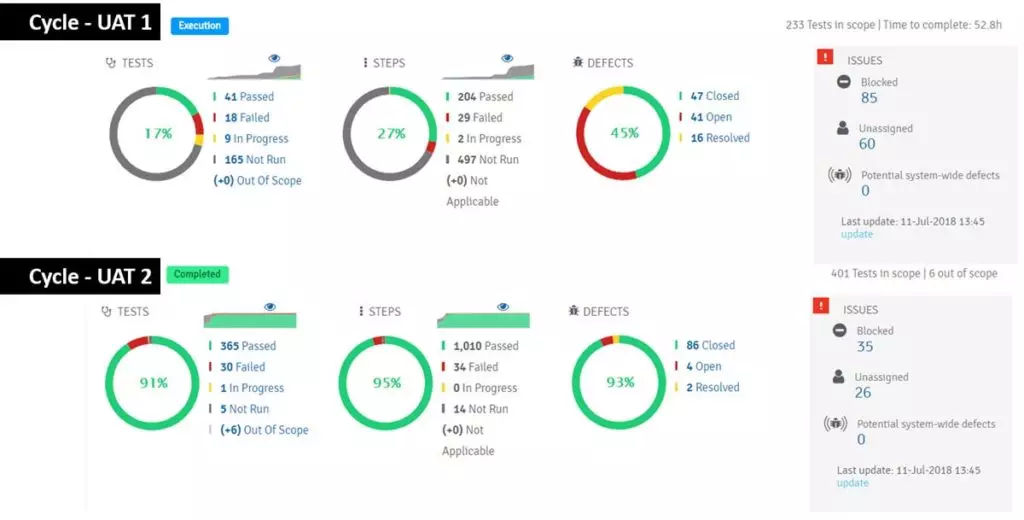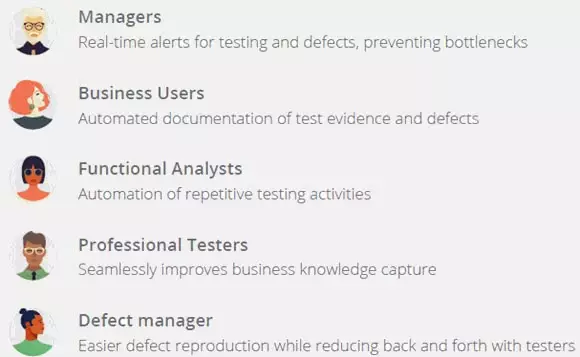What Does Uat Stand for on Timesheet
What is UAT Testing?
User Acceptance Testing (UAT) is the final stage of any software development life cycle. This is when actual users test the software to see if it is able to carry out the required tasks it was designed to address in real-world situations. UAT tests adherence to customers' requirements. UAT testers aim to validate changes that were made against original requirements.
Why Run UAT?
Without proper UAT, changes may appear as though they have been completed. In reality, there might still be work to be done. This problem may only be discovered by users, after the platform is released.
In this case, reverting to running a more thorough UAT test is not the highest cost. The loss of reputation is. UAT is performed to answer the question,"Have we produced the result that customers want?"
Thorough, well-thought-out, well-designed UAT tests are important for accurately capturing user requirements in a direct, verifiable way. High-quality tests are also essential for identifying problems that would otherwise go unnoticed by integration or Unit tests. Finally, UAT tests provide a macro-level overview of how complete the system is.
Similarly, UAT tests are also a good safeguard against problems that happen when change requirements aren't effectively communicated to developers. Developers may think they followed requirements to the letter, but only realize if they made an error after it was released to customers. This is an especially common problem when requirements change during a project. Sometimes, news of these changes doesn't reach the developers who need to implement them..

User Acceptance Testing – Simplified
Help business users make acceptance testing a priority by simplifying it. Gain user adoption and execute faster and safer UAT cycles.
Get the Guide >
Who Runs UAT?
Functional experts and business users are both needed for UAT. Experts oversee the technical side of software development. However, business users are still absolutely critical to a successful UAT test. After all, they're the only ones who know exactly what the change outcome must look like. The software can be completely functional from a technical standpoint and still fail because it doesn't meet the change requirements' standards. This is true for packaged application testing as well.
For example, a new purchase order has been improved to include a new subfield of Internet orders. A Unit test could confirm that. An acceptance test must ensure that the same purchase order functions properly. The new format for the purchase order should function properly throughout all of the purchase-to-pay processes. This includes initial creation, approval, receipt and invoice creation and finally, accounting.
This block renders a quote for the post drawn from the post's custom fields. Modify the quote below the content editor in the Quote fields.
How to Best Manage UAT
If you've gotten that far, you're at the tail end of testing the latest changes to your packaged application. If you're still using Excel or traditional test management tools, then your UAT team is probably working in one of these two modes:
You are chasing your business users around
You are rounding up your globally dispersed business users for a session of round-the-clock testing
If the first scenario sounds familiar to you, you will probably be on the verge of a nervous breakdown. Stakeholders aren't responding to your nagging requests. While, at the same time, nagging you to get their changes delivered on time. Better done yesterday. Even when testing is in progress, you have no visibility into the current status.
The second scenario, though confined by timelines, can be very expensive. Flying in business users from around the world to a single location is not the most effective solution. Nor is navigating through a sea of post-its.
Following the right phases is essential to the success of your UAT tests. Fortunately, the five phases of UAT are fairly straightforward.
1. Knowledge Gathering for Test Plan
UAT test planning should always begin by gathering the information required to create a comprehensive test, one that stands the best chance of successfully testing for the requested changes. Here is a list of information items that must be included:
- The list of business processes that should be tested
- Guidelines for which data to use
- Intended test results
- The UAT team responsible for testing
- The sequence of actions or test steps that must be followed at a high level
Generally, the entire process requires a large degree of collaboration between the integration manager, the different functional leads, and the relevant business process owners.
2. UAT Scoping
Not all business process must be tested. Some can be safely ignored. You should never begin UAT until you've defined the scope of your project. You'll find that it tends to balloon pretty quickly. Unless you scope in advance, It can become difficult to decide what is critical for the success of your test
3. UAT Design
Once you understand the scope of your UAT test, you can move on to designing it – mapping and assigning different and business steps to users and setting timeline for testing. You'll also be using the information you gathered in the first step to designing your test. As time goes on and you have use cases to reference, this step will become much easier.
4. UAT Execution
With your UAT process clearly defined, you can now execute it and decide if you should move ahead to production or not. In order to successfully execute your UAT test, you need this step to be extremely efficient. Several elements you need to put emphasis on are documentation and progress reporting, and defect management which requires flawless communication and balance between tests and developers.
5. Confirm Business Objective
Once execution is over and as many defects as possible are resolved, it is time to assess the risk for go live and sign off on UAT. The sign off approval indicates that the change meets business requirements and is ready for deployment.

How Can You Make Your UAT More Effective?
With the right tools in place, you can easily streamline your User Acceptance Testing (UAT) and reduce up to 50% of the time and effort you have been expending until now.
Scope as Needed
When it comes to scoping your project, you can't get very far without input from your business users. Yet getting them to list all important information in spreadsheets is incredibly time-consuming. The right test management solution would be able to guide users through this process, intuitively, so that instead of having to rescope each project from scratch, a test management solution can repurpose test plans so that users can get started immediately.
Plan Right
Engaging both your functional and business users under a standardized platform from the start is key to ensuring tests reflect actual end-to-end business processes. The right solution will offer collaborative technologies to coordinate among cross-functional, globally-dispersed users, and intuitive enough to ensure that your business users are engaged in the process.
Accelerate Test Execution
Copying and pasting screenshots of test results into Word or Excel is very time-consuming. Speed up your UAT Testing with automated documentation, workflow, and defect management to optimize test execution as you document planned tests using a recorder or via exploratory testing. The right tool will help you document tests via a recorder and then playback as needed to accelerate testing and reduce the back and forth between software development and testing.
Evaluate & Monitor
When you start off with a business-process centric approach, it's much easier to track testing processes throughout the test lifecycle. So instead of relying on unmanageable and unreliable Excel sheets, leverage real-time dashboards to help you track multiple test cycles, in real-time, at both the test and business process level. Monitor defects and manage overdue tests by leveraging built-in reminders and notifications to proactively reassign tests or send reminders to relevant stakeholders.

Execution: Remove Idle Time and Relieve Bottlenecks
To your key users, UAT workflows often feel like running a blindfold relay race. Passing the baton has so many dependencies, which users are blind to. Still, they must wait their turn in a waterfall-type workflow. This is everything but agile. Enable your key users the benefit of executing their steps without dependencies, even in a multi-step, multi-tester business process. Do this with embedded workflow automation features like 'Time to Test' notification when it's a user's turn to test within the business process, 'Retest' notification to testers upon defect resolution and 'Close' notification to developers upon retest success.
Evaluation: Accelerate Defect Management with Built-In Collaboration Tools
Globally dispersed key users are bound to have time-zone and communication issues that would make their whole testing experience even more excruciating than it normally is. Instead, to reduce waste of time on back and forth communication between testing and development teams, the right management tool would automatically attach the steps to reproduce the error at the time of defect creation. Also, when a defect is found, the right management tool would automatically identify all other tests affected by it and block or send warnings to testers until the main defect is resolved.
UAT Process Documentation
Documentation of your UAT testing strategy and overall plan is important. It can improve the outcome of your current and future tests. It should include:
- Out-of-scope situations worth testing
- Expectations for the test
- General agreements about the standards for passing
- How to carry out the test
- Owners and participants
- Scope of work
- Venue used
Include any relevant test or use cases that were successful in the past. Remember to document tests structure and management, as well as their outcome. Document your test cases. Your documentation should be traceable and annotated.
UAT Test Case Outcomes
UAT results should be as easy as possible to document and access. Many test managers mistake Excel sheets for 'as easy as possible' to use. Here are some examples of the data you should include:
- Acceptance Criteria
- Business Impact (e.g. high, medium, and low)
- Business Requirement
- Comments
- Date Executed
- Expected Outcomes
- Name of Tester
- Pass/Fail
- Test Case Name
- Test Case Steps Defined
- Test Case Number
Your testers should independently record their UAT results. Documentation should be reviewed daily. Any issues identified early should be addressed immediately.
Sign-Off
Users should have well-documented requirements for what must happen before proceeding to production. Classify your issues as low, medium or high-impact test cases. Then, solve any that are medium or high before moving to production. Do not defer anything but the lowest-priority items.
Major UAT Challenges
Below are the most common UAT challenges. Consider them when designing your UAT test and throughout your testing process:
- Engaging non-technical, business users
- Easing collaboration between users
- Reducing idle time between testers
- Improving visibility and control over the entire testing process
- Ensuring a high quality of test evidence without impacting user productivity
- The time and costs of flying testers to the same location
- Business users availability
Simplify UAT Testing with Panaya
All of this sounds complicated? Choosing your testing management solution wisely can help to simplify your UAT cycles. Looking for a UAT management tool, companies like AGC, Shiseido, and others come to Panaya for help. In rolling out cross-organization, multi-geography UAT project, enterprises are focused on meeting the following requirements:
- Greater key user adoption
- Better ROI
- Fewer bottlenecks
- Total visibility
Accelerate Testing Processes For All Stakeholders

Hear from Our Customers
"We would not have been able to do the testing that we did if we hadn't had the automation and the acceleration potential that Panaya brought to the table."
Maximilian Mayrhofer | Global Program Manager , Allianz Global Investors
Read the Full Case Study >

"We loved Panaya TDx for its collaboration features. It is a user friendly, cloud based solution that offers easily repeatable test scenarios between similar projects. We would recommend it to any other organization running SAP"
Pam Brown | Senior Director, ERP Business Process Organization, Bruker
Read the Full Case Study >
To get all of the above, It is important to choose a tool that mirrors real business processes. Panaya Test Dynamix is an end-to-end testing solution. It can simplify UAT and reduce testing effort by 30%. User Acceptance Testing is no longer a battle. Download the eBook How to Simplify UAT Testing for additional insight into how you can streamline and simplify your UAT processes.
With this eBook, learn how to:
- Automate more elements in your user acceptance testing
- Incentivize key testers with ease-of-use
- Gain business users' adoption

User Acceptance Testing – Simplified
Help business users make acceptance testing a priority by simplifying it. Gain user adoption and execute faster and safer UAT cycles.
Get the Guide >
Frequently Asked Questions
What is User Acceptance Testing?
User acceptance testing (UAT) is the final and most critical phase of the SW testing project before go-live and rollout. During UAT, actual users test the software to validate that it is performing according to the required real-life scenarios.
What Comes Before UAT?
UAT comes after unit testing and QA and before rollout or go live.
Why is User Acceptance Testing Important?
UAT (User Acceptance Testing) is a crucial step when implementing. It is the phase where real users use real-life examples to see if the SW behaves as expected, and is suited to end-users' needs, and as such, it is a step where many defects are raised. It is often the final stage of the implementation process.
What are the steps of UAT?
1. Planning
2. Execution
3. Documentation
4. Evaluation
5. Reporting & Lessons Learned
What Does Uat Stand for on Timesheet
Source: https://www.panaya.com/blog/testing/what-is-uat-testing/